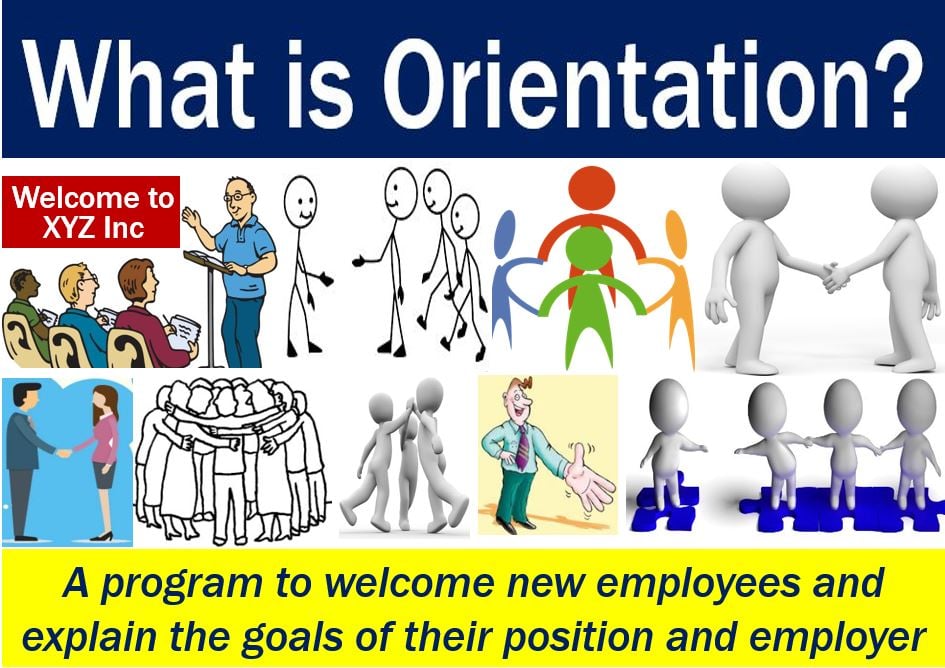The term Orientation, in human resource management, refers to a part of the process of assimilation of a new employee. It is part of a new worker’s socialization process in a company or any organization. In other words, an orientation program is a part of orienting new employees to their jobs and workplaces.
Not only are the programs important for the new employee, but also for the employer. Some people use the term ‘onboarding‘ with the same meaning.
It aims to reduce employee anxiety and help them understand what is expected of them. It also aims to gain worker commitment and convey what they can expect from their job and employer.
Not all employees are the same. Therefore, the program needs to incorporate a sensitive awareness of newcomers’ anxieties. It should also incorporate the needs of the employee.
Existing employees
Orientation programs are also important for existing employees who the employer promotes to higher positions. Although the content of the program for existing employees is different, the aims are the same.
A good program will get the employee up-and-running more quickly. It will also improve employee retention and help them succeed in their new position.
The rest of this article focuses on programs for new employees and why they are so important.

Orientation – a neglected procedure
Dr. Judith Brown writes in an article in The Balance that orienting employees is a function many employers neglect. In fact, she claims it is “one of the most neglected functions in many organizations.”
Unfortunately, too many people complain that their program was overwhelmingly boring. Many newcomers have also complained that their new employer left them to sink or swim.
A common mistake employers make is to dump too much information on the new employee. The company then expects them to understand and implement too much too quickly.
If you load too much information onto newcomers and then expect them to get on with it, what do you get? You get confused employees who are far less productive than they could have been.
An overloading orientation process also makes it more likely that the employee will leave within a year.
Put simply; a bad program is counterproductive and costly for both the employee and the employer.
An effective program helps not only employee retention but also their productivity. Productivity refers to how much a worker produces over a specific time, i.e., per hour.
If your company has a good orientation program, its new employees will be up to speed faster. There is also a better alignment between what the new worker does and what the company needs them to do.
Aims of orientation
Employee orientation aims to educate newcomers about goals and responsibilities. Not only about the goals of their position but also those of the company.
The program must also answer any questions new employees may have about human resources, payroll information, and benefits.
To have an effective orientation program, there must be cooperation between people from various departments. Specifically, people in the HR department must cooperate with other managers and supervisors.
Does this mean that smaller employers cannot have new employee programs because they do not have an HR unit? No, it does not.
With smaller employees, the head of, for example, the machine shop, is responsible for orientation.
If you are a small employer and need advice, there are two choices. You can either get an outside specialist to help you or learn about it online.
The Role of Technology in Modern Orientation
Many companies, especially large corporations and tech businesses, are leveraging digital platforms to enhance the orientation experience for new employees.
Virtual reality (VR), for instance, offers a unique way to immerse new employees into a company’s culture and work environment without them being physically present.
Similarly, mobile applications can provide interactive onboarding checklists, tutorials, and training modules that can be accessed on the go.
With an increasing number of people, including new employees, working remotely, digital onboarding processes have become crucial. Platforms like Zoom or Microsoft Teams enable virtual meet-and-greets, ensuring that even remote employees get a sense of the team and company culture.
To make the process more engaging and memorable, some employers have implemented gamified orientation modules. Technology can help newcomers absorb and retain crucial information.
Technology is evolving rapidly. Businesses, organizations, and other employers must stay updated and incorporate these tools to ensure a smooth and effective orientation process for all employees.
